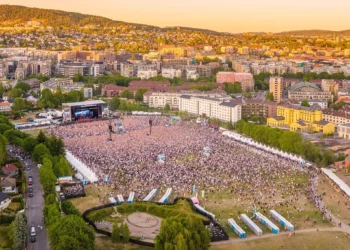This project aims to explore the application of UX principles in live concert settings with the goal of enhancing audience experiences. It is well-known that many concert or festival attendees face various inconveniences, such as long queues for drinks or people talking during the concert. These seemingly small annoyances can have a significant impact on the overall experience and can even affect the audience’s perception of both the venue and the artist. Therefore, the main objective of this project is to identify and analyze the main pain points that attendees face when attending a live event. By thoroughly understanding the causes of these issues, I want to then explore design solutions that address these concerns. In many ways, the concert experience differs from other projects we work on as designers, as the primary goal for all stakeholders is to prioritize the end user experience. However, supporting systems and tasks, such as buying beer or access to toilets, are often overlooked or given less attention.
In many places, it is difficult to eliminate things like queuing for beer or people talking. However, there are still ways to enhance these experiences. How can one effectively organize a long queue, discourage people from talking, or otherwise address the pain points people are experiencing without necessarily eliminating them?
Central research questions
As this is a very open project, the research will also be very open, at least at the start. The goal is to explore how UX methods can be utilized in a very physical experience, but there is no clear „problem“ that needs to be solved, so finding the main problems that can be worked on will also be central to the research.
- What are the audience’s main pain points when attending a concert?
- What are the venue’s main pain points when hosting a concert?
- How can UX be utilized in physical spaces?
- What works really well at some venues and why?
- What are the main factors for great experiences for audiences and employees?
Application in the field of interaction design
The field of UX design is ever-expanding, and therefore, I think this is a very interesting project to apply our skills in UX too. Our design field is about understanding human needs and how we can create better services for them, and that is the main focus of this project. Even though it does not focus on digital experiences, many of the same methods can be used to understand the user and create better services. The end result and recommendations are different, but the application of methods is, in many ways, the same. I also think that this project will have a strong systems design approach, therefore i want to apply methods like giga mapping and affinity mapping to the research i will be doing.
I also want to explore how other fields can be used in the setting of concerts, particularly airport design, as some modern airports do an incredible job of moving large quantities of people through every day. I also want to conduct more in-depth interviews with classmates and people who work at venues to get more data on the main pain points people face.
The intended plan for the research will be to continue and try to find relevant research, articles and institutions, as it is not a large field and finding articles and resources has been quite difficult. This is also what I think will be one of the main challenges of this project: finding material to support my decision-making. So far, I have struggled to find articles or institutions that are highly relevant to this project, and therefore the research is at times quite challenging. Another main challenge will be narrowing it down to something more concrete, as it is a very vast space with many different directions to explore. The challenges that a large festival faces are very different from those of a smaller venue that hosts concerts throughout the year.
Personal motivation
I have been working in the live concert industry in Norway for the past 5 years and have developed a personal interest in these types of experiences. However, over the last couple of years, I have primarily attended these events for work rather than for pleasure. I have developed a keen interest in understanding how these events work and in finding ways to improve them. This includes considering the perspectives of both the audience members and the individuals working at these shows, who often encounter frustrations with the events. I have also wanted to find a way to combine my studies in interaction design with my job as a lighting engineer. I believe that this will be an interesting way to merge these two passions.
Some relevant links:
/https://www.bmkoes.gv.at/dam/jcr:8fb046c7-edb8-4a21-ae94-e536ccec3dc0/Kulturelle Beteiligung in Österreich_Executive Summary EN.pdf
